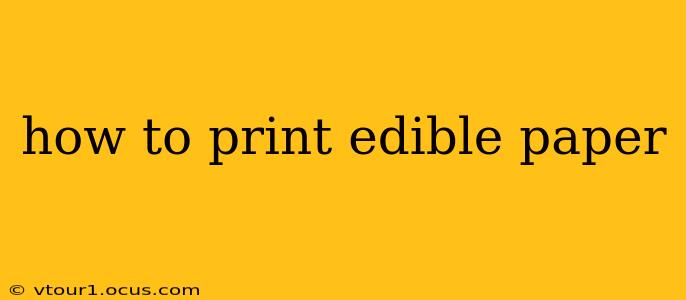Printing on edible paper opens a world of creative possibilities, from personalized cakes and cookies to stunning edible images for cupcakes and other desserts. But knowing how to get crisp, vibrant prints requires more than just slapping a sheet in your inkjet printer. This guide covers everything you need to know, from choosing the right paper to troubleshooting common issues.
What Types of Edible Paper Are There?
There are two main types of edible paper: wafer paper and icing sheets.
-
Wafer paper: This thin, crisp paper is made from potato starch and water. It's ideal for delicate designs and intricate details, but it's more fragile than icing sheets. It's often used for smaller decorations or for applications where a crisp texture is desired.
-
Icing sheets: These sheets are thicker and more durable than wafer paper. They are made from a cornstarch-based material and have a slightly glossy finish. Icing sheets hold up better to moisture and handling, making them a popular choice for larger images or applications where the image needs to be robust.
What Printer Do I Need to Print on Edible Paper?
You'll need an inkjet printer to print on edible paper. Laser printers use heat and toner, which are not food-safe. Make absolutely sure your inkjet printer is dedicated to edible printing and not used for regular printing—contamination can be a serious health risk.
What Kind of Ink Do I Need?
It's crucial to use edible ink specifically designed for printing on edible paper. Regular inks contain chemicals that are toxic when ingested. Edible inks are food-safe and come in various colors to match your creative needs. You can usually find these inks in cartridges or as refills for your printer.
How to Print on Edible Paper: A Step-by-Step Guide
-
Choose your edible paper: Select either wafer or icing sheet, depending on your needs and the design complexity.
-
Load the edible paper: Carefully load the paper into your printer according to the manufacturer's instructions. Edible paper is often more delicate than regular paper, so be gentle. Some printers may require special settings or adjustments for this type of paper.
-
Choose your image: Select a high-resolution image. Low-resolution images will appear blurry when printed. Ensure the image is the correct size for your application.
-
Print your image: Use the appropriate settings in your printing software. The specific settings depend on the type of edible paper and printer, but generally, you want to print using the highest quality setting.
-
Let it dry: Once printed, allow the image to completely dry before handling or applying it to your cake or other food items. Drying time will vary based on the humidity and type of paper.
How Do I Apply the Edible Image?
The method for applying the edible image depends on the type of edible paper and the food item:
-
Cakes and Cupcakes: Gently peel off the backing sheet (if applicable) and carefully place the image onto the frosting, ensuring it's smooth and wrinkle-free. Use a soft brush to gently smooth out any air bubbles.
-
Cookies and Other Treats: For cookies or other treats with a flat surface, follow the same process as above. For curved surfaces, you may need to carefully trim the image to fit.
Troubleshooting Common Problems
My image is blurry: This is often due to low-resolution images or incorrect printer settings. Use high-resolution images and ensure your printer is set to the highest quality print setting.
My image is smudging: This may happen if the ink hasn't fully dried. Allow ample drying time before handling the image.
My image is tearing: Wafer paper is delicate. Handle it carefully to avoid tearing.
Is Edible Printing Expensive?
The initial investment in edible paper and ink can seem high, but the cost per image is relatively low, especially when you consider the impact on the visual appeal of your creations.
Where Can I Buy Edible Paper and Ink?
Edible paper and ink are readily available online and in some specialty baking supply stores.
By following these steps, you can easily create stunning and delicious edible images for all of your baking projects! Remember, practice makes perfect, so don't be discouraged if your first few attempts aren't perfect.
